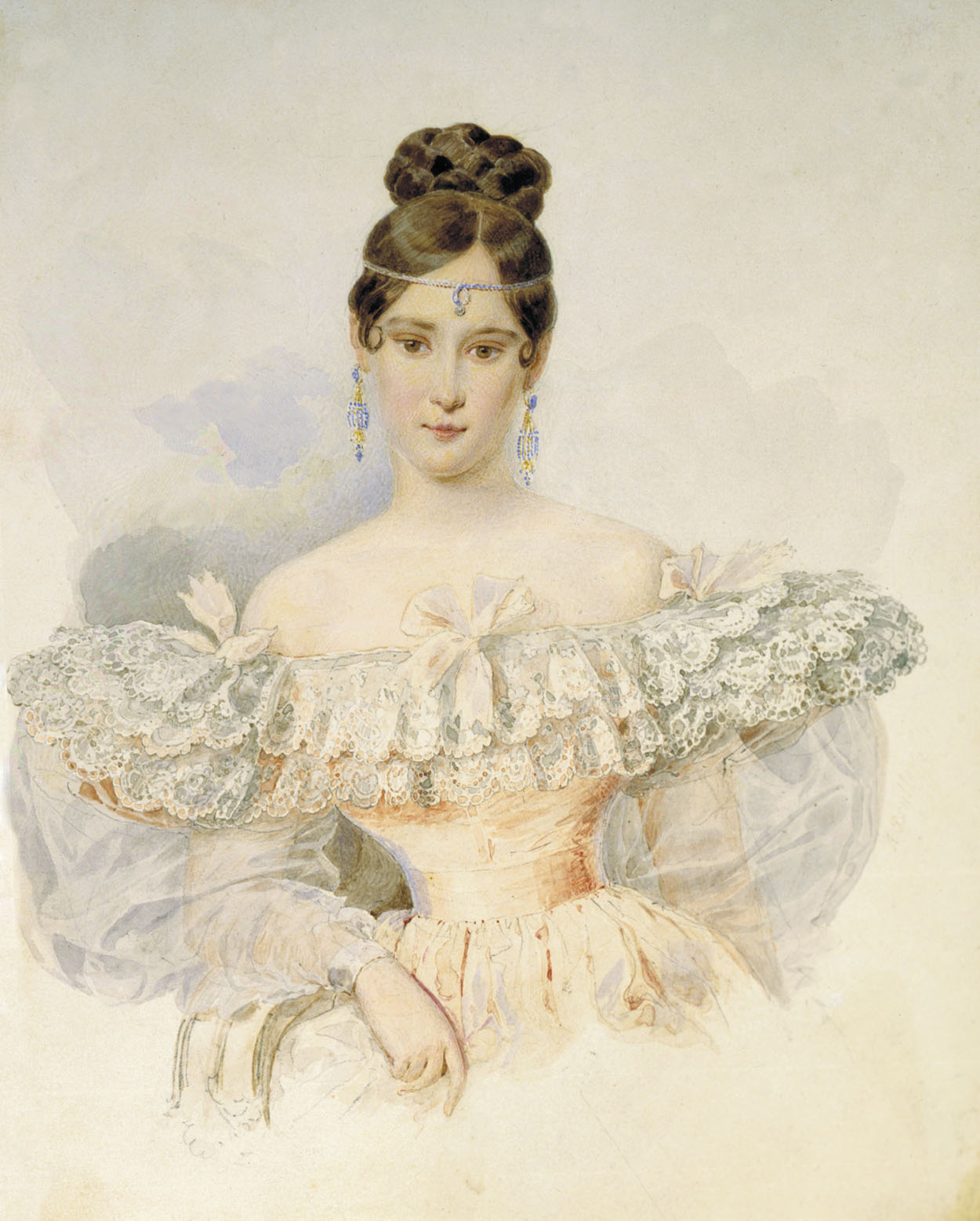Ferronnière on:
[Wikipedia]
[Google]
[Amazon]

 A ferronnière is a style of
A ferronnière is a style of

 A ferronnière is a style of
A ferronnière is a style of headband
A headband is a clothing accessory worn in the hair or around the forehead, usually to hold hair away from the face or eyes. Headbands generally consist of a loop of elastic material or a horseshoe-shaped piece of flexible plastic or metal. T ...
that encircles the wearer's forehead, usually with a small jewel suspended in the centre. The original form of the headband was worn in late fifteenth-century Italy, and was rechristened a ferronnière at the time of its revival in the second quarter of the nineteenth century for both day and (more frequently) formal and evening wear.
Etymology
The term ferronnière for describing such headbands was probably coined in the early nineteenth century. Merriam-Webster date the earliest use of the term to 1831, and theOxford English Dictionary
The ''Oxford English Dictionary'' (''OED'') is the first and foundational historical dictionary of the English language, published by Oxford University Press (OUP). It traces the historical development of the English language, providing a co ...
notes that their record of the earliest usage of the term is located in a mid-19th-century publication called ''World of Fashion''. Some sources suggest that the term was contemporary to the 1490s.
The ferronnière is often said to be named after a 1490s portrait attributed to the school of Leonardo da Vinci
Leonardo di ser Piero da Vinci (15 April 14522 May 1519) was an Italian polymath of the High Renaissance who was active as a painter, Drawing, draughtsman, engineer, scientist, theorist, sculptor, and architect. While his fame initially res ...
, the ''La belle ferronnière
''La Belle Ferronnière'' () is a portrait of a lady, usually attributed to Leonardo da Vinci, in the Louvre. It is also known as ''Portrait of an Unknown Woman.'' The painting's title, applied as early as the seventeenth century, identifying t ...
'', where the sitter wears such an ornament. However, this painting's title was assigned in the 18th century, well after it was painted, under the erroneous assumption that it portrayed Madame Le Féron, a reputed mistress of Francis I of France
Francis I (french: François Ier; frm, Francoys; 12 September 1494 – 31 March 1547) was King of France from 1515 until his death in 1547. He was the son of Charles, Count of Angoulême, and Louise of Savoy. He succeeded his first cousin on ...
; or another mistress who was allegedly an iron merchant's wife. The literal translation of ''ferronnière'' in English is "female ironmonger;" the term was used for the wife or daughter of an ironmonger
Ironmongery originally referred, first, to the manufacture of iron goods and, second, to the place of sale of such items for domestic rather than industrial use. In both contexts, the term has expanded to include items made of steel, aluminium ...
. In their catalogue, the Louvre
The Louvre ( ), or the Louvre Museum ( ), is the world's most-visited museum, and an historic landmark in Paris, France. It is the home of some of the best-known works of art, including the ''Mona Lisa'' and the ''Venus de Milo''. A central l ...
suggest that ''La belle ferronnière'' was so-called because of her forehead ornament, a theory that is supported by other scholars, but other sources conclude that the ornament was named after the painting, due to the term's specific application apparently not existing prior to the 19th century.
In fashion
The original ornament that later became called a ferronnière was popular in 15th-century Italy, where it could be made from metal or jewels. The nineteenth-century ferronnière was worn from the late 1820s to the early 1840s, when it was considered to enhance a high forehead, and by the 1850s, it had fallen out of fashion. One contemporary source from 1831 describes the ferronnière as "a small plait of hair, adorned in the centre of the forehead by a large brilliant, from which depends another brilliant of the pear shape." It has been described as one of the most widely worn examples ofhistoricism
Historicism is an approach to explaining the existence of phenomena, especially social and cultural practices (including ideas and beliefs), by studying their history, that is, by studying the process by which they came about. The term is widely ...
in early Victorian fashion, worn as a tribute to the Renaissance
The Renaissance ( , ) , from , with the same meanings. is a period in European history
The history of Europe is traditionally divided into four time periods: prehistoric Europe (prior to about 800 BC), classical antiquity (800 BC to AD ...
alongside beaded belts called cordelières inspired by medieval clothing and hairstyles named after historic women such as Agnès Sorel
Agnès Sorel (; 1422 – 9 February 1450), known by the sobriquet ''Dame de beauté'' (Lady of Beauty), was a favourite and chief mistress of King Charles VII of France, by whom she bore four daughters. She is considered the first officially r ...
and Blanche of Castile
Blanche of Castile ( es, Blanca de Castilla; 4 March 1188 – 27 November 1252) was Queen of France by marriage to Louis VIII. She acted as regent twice during the reign of her son, Louis IX: during his minority from 1226 until 1234, and during ...
. The ferronnière could be worn for either day or evening. Alternative terms for similar ornaments were the bandelette and the tour de tête.
References
{{DEFAULTSORT:Ferronniere 15th-century fashion Headgear 1820s fashion 1830s fashion 1840s fashion Types of jewellery 1830s neologisms